A gardening enthusiast, whether it be for commercial or personal use, often incorporates compost in hopes for the best results possible for their crops. Compost is created through a natural process when recycling organic material turns into a rich supplement for the soil. It’s so good for gardening that it’s been nicknamed by some as “black gold”.
However, compost can be rather costly to purchase, averaging in most areas about $25 to $35 per cubic foot. And, if you have a large garden area, that can add up very quickly.
So, many people turn to making their own compost. In fact, there are several tools available to help make your own. But, what if you want a lot of it for spring planting, and you are entering the cold winter months?
Fortunately, you can make compost even in the winter…and lots of it. And, it’s easy and it only requires 2 ingredients! One is fallen leaves, which are abundant heading into winter. If you don’t have your own, a trip down the road you might spot several brown bags stuffed with leaves, just waiting to be picked up. If you ask, they probably won’t mind if you pick them up, rather than the garbage truck.
The other ingredient is used coffee grounds.
Composting Leaves with Coffee Grounds
You should first determine how many leaves and coffee grounds you will need. So, plan out what you will be planting in the spring to gauge how big of an area you will need. I will be doing a very small area for the purpose of demonstration in this article. But, even for a relatively small garden, start collecting leaves ahead of time.
Now, on to the coffee grounds. I doubt too many of you drink enough coffee to gather up the amount of coffee grounds you will need for this project…unless you start collecting months prior to composting.
I called our local Starbucks to see if they would collect a couple days worth of used coffee grounds for me. I fully expected them to be confused. But apparently, they save used coffee grounds for gardeners. If your local Starbucks does not save these, call another one nearby, or any coffee house. You can stop in there a few times a week to collect their grounds, if you are hoping for a large garden.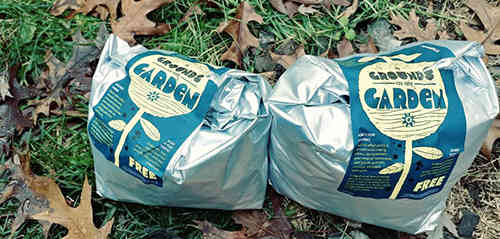 So, not only is this composting easy, but it’s free!
So, not only is this composting easy, but it’s free!
The Basics of the Composting
Composting takes a little bit of “brown” and a little bit of “green” to create a rich supplement for gardening. Dried, or fallen leaves fall into the “brown” category, while the coffee grounds play the role of “green”. Yes, even though coffee grounds are actually brown, and leaves are often green.
The “brown” in composting is producing carbon, and the “green” brings the nitrogen. And, both are necessary components for the compost to thrive. Organic matter will eventually compost down without help in time…lots of time. However, not everyone wants to wait that long.
Related: How I Grow My Herbs Indoors
The Process of Composting with Leaves and Coffee Grounds
It’s a very simple process. The hardest part just might be deciding where you want to put it. But, a good option would be right where you plan on planting in the spring. The leaves and coffee ratio is 4 to 1 parts. So, if you have a lot of material, use a shovel to make it easy.
Make a layer (remember 4:1 ratio) of leaves on the ground, or in a shallow and long bin or a raised garden bed.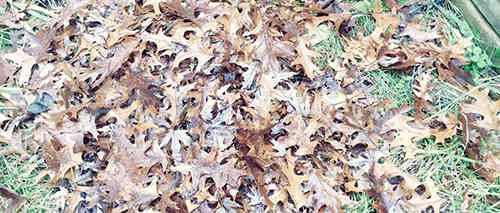 Sprinkle, or use a shovel to make a layer of used coffee grounds over the leaves.
Sprinkle, or use a shovel to make a layer of used coffee grounds over the leaves.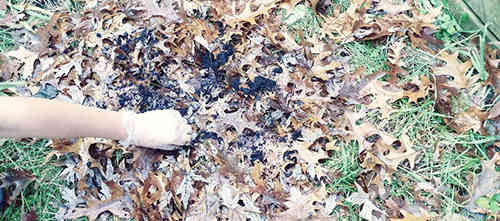 Lightly sprinkle the pile with water, unless you are starting with a wet pile.
Lightly sprinkle the pile with water, unless you are starting with a wet pile.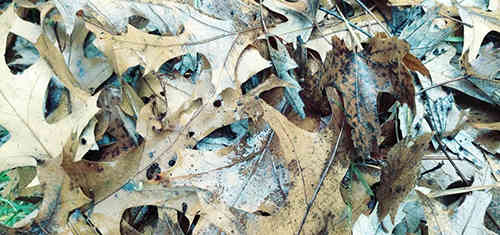 Repeat each step until you run out of material, or think you have enough. Make sure that each layer is damp as you go. Just remember, as it goes through the process, the pile will appear to shrink.
Repeat each step until you run out of material, or think you have enough. Make sure that each layer is damp as you go. Just remember, as it goes through the process, the pile will appear to shrink.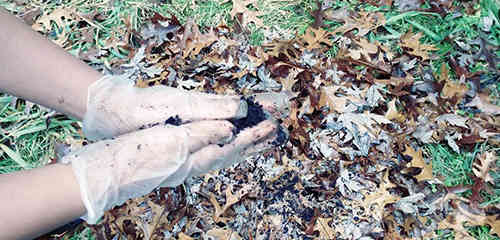 Once you have your pile all set, turn the pile every few days. Check to make sure it looks and smells fine, and isn’t drying out too much. If it is, dampen it again.
Once you have your pile all set, turn the pile every few days. Check to make sure it looks and smells fine, and isn’t drying out too much. If it is, dampen it again.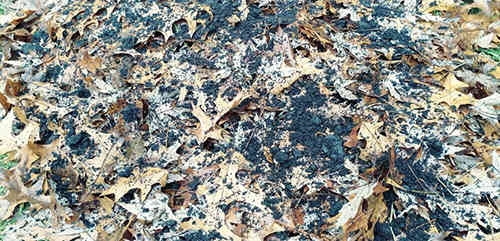 You could also start with mulched leaves, which will significantly speed up the composting process. However, if you are going to use mulched leaves, change the ratio from 4:1 part, to 1:1 part.
You could also start with mulched leaves, which will significantly speed up the composting process. However, if you are going to use mulched leaves, change the ratio from 4:1 part, to 1:1 part.
Extra Tips in Composting
There are other “browns” you could use in place of or in addition to leaves, such as:
- Shredded paper/cardboard
- Hay
- Mulch
- Wood chips
And other “greens” that could be used in place or in addition to used coffee grounds include:
- Vegetable
- Vegetable or fruit peels and skins
- Used coffee filters
- Manure
- Tea bags
- Grass clippings
However, using any of the following is NOT recommended:
- Pet fecal matter or waste
- Meats or bones
- Fats or oils
- Dairy
- Diseased plants
- Anything with pesticides
Pay attention to the smell of the pile. It should have an earthy aroma. If it starts smelling bad, add more nitrogen, or “green”. Also, pay attention to the texture. If it’s slimy, add more carbon, or “brown”. Don’t confuse slimy with dampness. You want it to be damp, just not slimy.
Winter Composting
Even though the process will slow down in really cold regions, that’s OK. You should continue to add some “brown” and “green” to the pile every occasionally throughout the winter, even if it freezes. It will thaw eventually, and the thawing and freezing ebb and flow will contribute to the compost breaking down faster come springtime.
In the spring, throw some hay over the pile to help protect it until you are ready to use it, because it will let off an aroma when thawing, attracting critters.
Use it within the soil when you plant your spring crop.
You may also like:
 How to Make a 55-Gallon Compost Tumbler Fast, Cheap and Easy
How to Make a 55-Gallon Compost Tumbler Fast, Cheap and Easy
This Strange Method Will Make Your Food Last For 2 Years Without Refrigeration (Video)
How to Adjust the pH in Soil and Water for Abundant Harvests

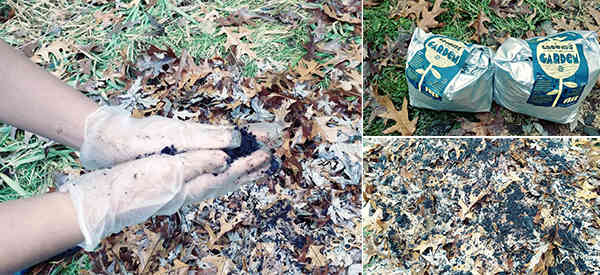













Article pretty much covered everything. Good job. Egg shells are good to put in there as well. Chickens help because when you clean out the coop all the wood chips in there are coated with their poo and that is always a plus.
Wannabe: Isn’t chicken manure too hot to use directly on your garden? I thought it had to age before it could be applied? Or do you just add it to your compost heap and let it age that way?
Left coast, I add it to compost pile and it sits for several months before mixing into rows. It has plenty of time to break down and be of no harm to plants
Manure makes a good “green” to add to your compost. It’ll help “cook” the heap for hot composting.
Even the Starbucks inside a grocery store will save the coffee grounds. Here in SoCal the Starbucks inside the local grocery puts the coffee ground back in the foil bag the coffee original came in and seals it with a sticker that Starbucks has made specially for that purpose. The bag is about the size of a10 # flour bag. They put out a few bags each day and they are quickly gone.
If you go to a stand-alone coffee shop you will get more grounds. Be prepared to carry a heavy bag as a bag full of wet coffee grounds is heavy. You will also get all the paper filters. That’s not totally bad, however, as you can run the coffee filters through your paper shredder if you have one or your garden shredder if you have one of those and use the ground up coffee filters for additional mulch.
I have used the smaller quantity of coffee grounds that I develop at home for years in the garden.
There is an urban rumor that ants don’t like coffee grounds and if you have ants in the ground and you apply coffee grounds around the ant colony they will move to another neighborhood. I haven’t been able to personally verify the veracity of that urban rumor.
I can report that the amount of coffee grounds around my persimmon trees increased substantially this year and I noticed reduced number of ants in the fruit when I picked it. That isn’t enough, however, to convince me of the accuracy of the coffee vs. ants legend.
How would it work if it was flipped infrequently?
Still would be fine. Think of what happens in nature. Nobody’s out there turning it.
If flipped infrequently or not at all, you’ll be cold composting (ie the pile doesn’t heat up) which means it will take significantly longer for compost to happen, but it will happen, and it’s a lot less work than getting the mixture right and turning every week or two and moving from pile/bin to pile/bin in order to keep hot compost going, but you can have fresh compost in a whole lot less time with that effort, if that’s your desire.
As a note on getting wood chips for mulch or to compost down, you can use https://getchipdrop.com/ (Chip Drop). They work with local arborists to drop the wood chips at your house. The caveat is that you don’t get to choose how much you want…it’ll be a full load (12-15 yards usually). I did this and got plenty to mulch all my flower beds as well as some erosion control and still have a big pile in backyard. My mind had slipped or I would’ve chased up some coffee grounds to go into that pile to help compost it down more quickly. I may hit a couple of coffee shops in the morning for that purpose.
I’ve been composting for several years now. It’s AMAZING how much better the veggies are, and my flowers are stunning.
I have a little container near the kitchen sink. As I make my salads and other vegetable dishes, I collect whatever I’m not using. I also only eat organic bread, so if that doesn’t get eaten before going stale, that goes in as well.
What I started with was a 20-gallon plastic trash bin with a lid. Then I drilled holes all the way around it an in the bottom. I set this in one of those plastic kiddie pools for the first year (so I could capture the “compost tea” when I watered it.)
I started my compost with compost… that is, last year’s used up soil from my garden pots. I had a good year and only used organic fertilizer and soil, so it seemed like a good way to start. Then every morning, all the veggie clippings from yesterday go in.
I have a lemon and an orange tree, also only use organics on those. The leaves go into the bin along with all my shredded paper (not newspaper, just office paper.) I have a shovel sitting next to it, so each addition is followed by a deep dig with the shovel to turn it. I can also put the lid on and roll it, but as it has filled up, that has become more difficult.
I add coffee grounds every other day. My gardener said to go a little easy on those as it can make it really acid. So you want to be sure you are balancing it properly. One of the best ways to do that is with earthworms, which you can find both in fishing stores and in your local nursery.
I’m in Phoenix, though. So in our hot hot hot summers, the worms either sneak out through the holes or they just die from heat exhaustion!
After two years of doing this, I took the bin out of the kiddie pool. It was too difficult to manage it as it got heavier. But the side benefit is that I placed the bin underneath my Jacaranda tree, so the compost tea goes into the soil there and has fertilized that beautifully.
This is a great adventure. I keep proudly showing people, “I made DIRT!” I’m sending it over to a lab after the holidays to have it tested. I know there are some articles online about how to not make it too “hot,” so I’m concerned about that. Crossing fingers this 20 gallon bucket is of something useful!
Thanks, Claude. You always write such great articles!
Dog & cat excrement shouldn’t be used, but some pets, like rabbits, guinea pigs, and chickens (all 3 are livestock/pet crossovers, hmm), litter & straw, hay, or organic paper bedding are all fantastic for composting, and in the case of rabbits & guinea pigs, can even be added directly to the garden, because they’re not ‘hot’.
I am certainly no expert at composting, but I understand that if the animal eats mostly vegetable matter, it is good to compost right from the source. Chicken and other birds because they sometimes eat insects (meat) have “hot” manure which has to age before it is put on plants. Meat eaters, dogs, cats, possum, raccoon, tigers manure is not suitable for composting. Interestingly enough, human manure was used on the Far East for many years. The big drawback to human manure is that it contains many pathogens that survive in the manure and while I don’t believe the bacteria and virus are drawn up into the plants’ systems, they most definitely are on the outside of the plant, the leaves and stems, and are thus consumed and infect the person who eats the plant without extreme washing. If you read about hepatitis C, you will learn that it is endemic throughout the region in Asia where night soil as human manure is called was used extensively in farm production.
A couple of years ago one of the big lettuce food poisoning scares was because the E-Coli bacterium was actually drawn up into the plant and no amount of washing would get rid of it.
I’ve collected leaves and run them through my push mower for many years each fall and composted them over winter, it’s warm enough here they finish by spring w/o adding anything to them, just keep them watered and turn the pile every week. Haven’t tried coffee grounds but you can also mix in a bag of organic fertilizer or some humic acid to speed the process. Also, a lot of the suburban cities around me collect and compost yard waste and sell it to the public cheap. Can buy good finished compost from the big commercial companies for 50.00/yard which is about a pickup load. Of course if you make your own you know what’s in it.
Such a helpful article! Clear, well written, easy to understand.
Wish I had known this at the beginning!
Two mistakes I made when I started composting. One: A farmer down the road was delighted to haul his chicken droppings (I think it was 2 dump truck’s worth) to my place for a nominal charge, maybe $50. Unfortunately, they were “hot” = uncomposted. My neighbors would have had my hide if they weren’t so decent, every time the wind blew the smell their way. Because it was a large, dense, unaerated heap, it took forever for the surface of the pile to break down enough for the smell to be bearable. I was able to take off about 3″ of dried chicken droppings from the surface at a time to use in my vegetable garden. I don’t remember how many years that process took, maybe 5 years. Don’t do that.
#2 mistake: When we got our chipper/shredder, we gleefully shredded all the neighbors’ leaves and twigs, all carbonaceous, and went to work piling the lovely mulch-ish stuff around our young plants. Because we didn’t have any nitrogenous material mixed in, all our plants turned light green. Don’t do that, either.
It takes some of us longer to grasp processes than others.
In time, my raised beds grew and raised lush, healthy, almost tropical-looking plants, like 10′ tall indeterminate tomato plants. Almost never a bug. The deep humus held moisture through months-long droughts without watering. The neighbors didn’t believe me, but you know it was true if you are a gardener who composts and mulches.
Keep on keeping on. A garden diary is a helpful learning tool, too. Pictures are heartwarming when you do it right, too.
Great post, Lucy. It is a real teaching lesson when you can learn what not to do along with what to do. Thanks for posting your mistakes so that the rest of us at least have a head start on what not to do. In an ETOW situation, a mistake like no nitrogen could mean the difference between life and death.
The chicken manure pile might keep away unwanted, however. At one time our county had the largest egg producing plant in the world. I don’t remember how much chicken manure they hauled out of their each day, but I couldn’t believe the numbers when I first heard them. It was hundreds of truck loads a day. I figured each truck was probably a 2 1/2 ton dump truck so you can figure 100 trucks times 10,000 pounds per truck. They sure weren’t hauling it in pickup trucks.
We don’t have right to farm laws here in the PDRK, so when the folks from the city moved to the country to enjoy rural life, they were considerably shocked when the wind blew wrong. Chicken manure hauling was a full time, 7 day a week job handled with front loaders and scrapers.
Eventually the egg factory had to close due to numerous complaints by the city folk who didn’t understand that raising commercial eggs isn’t Farmer Brown going out to the hen house each morning to pick up a couple dozen eggs. It’s a factory with all the noise, truck traffic and smells of an odiferous factory operating in commercial zoning, i.e. farming zoning. But there were more votes from the city folk than there were from the farm laborers who were out jobs when the egg factory closed.
I like to use leaves to fill in bulk for my worm bin. Its 4 f x3′ by 1 foot deep. I have a family of 3 and that’s about all the waste my worms can handle. When I use leaves they eat up the kitchen waste while the leaves decompose and leave a nice fluffy soil behind instead of a clay like black sludge. Both are as rich in nutrients but the leaf compost is much easier to work with.
I enjoyed the input I never owned a farm of myown but knew others who did. And since I already learned to can and sew, I was pretty happy back then, except I had little help most of the time. I had plenty of time too thank God.
It took two seasons to get very good compost going and I’ll also add small broken twigs, very degraded pine cones broken up, egg shells and any garden refuse throughout the summer. This past summer, my yield was fantastic and expect better this year. Do you use it at all for seed planting in your greenhouse mixed with soil? I have not tried that yet.
Have any of you ever tried “drunken compost” I have and it works rather well, I have one of those “mini tillers” that hook to my weed whacker interchangeable power head
I’ve had decent success with the DC method http://reaganite71.blogspot.com/p/drunken-compost-recipe.html
you quoted a value of 25$ for a cubic foot of compost . Shouldn’t that be a cubic yard?